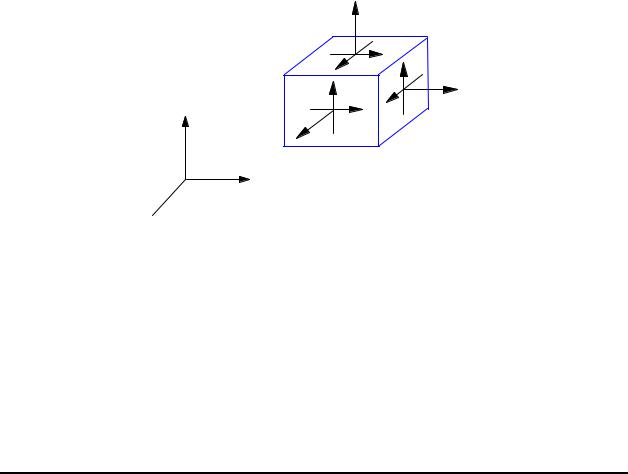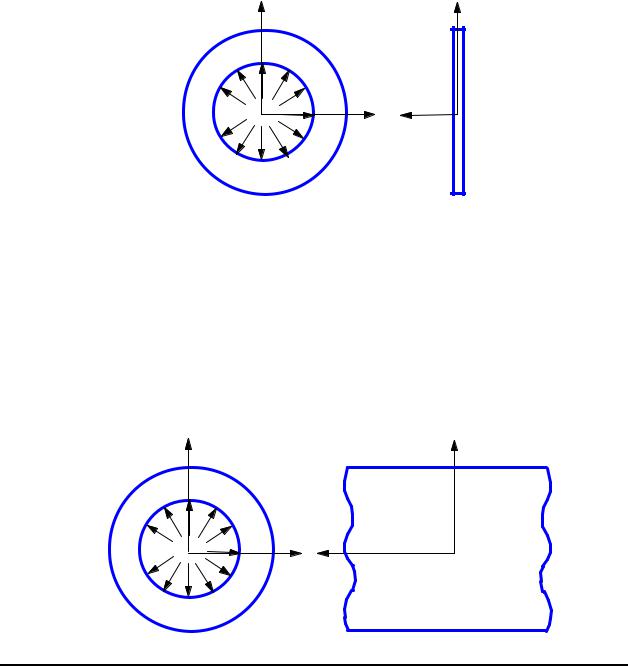
- •Copyright Notice
- •Table of Contents
- •Chapter 1. Introduction
- •I. Basic Concepts
- •Examples:
- •Why Finite Element Method?
- •Applications of FEM in Engineering
- •Examples:
- •A Brief History of the FEM
- •FEM in Structural Analysis (The Procedure)
- •Example:
- •Available Commercial FEM Software Packages
- •Objectives of This FEM Course
- •II. Review of Matrix Algebra
- •Linear System of Algebraic Equations
- •Matrix Addition and Subtraction
- •Scalar Multiplication
- •Matrix Multiplication
- •Transpose of a Matrix
- •Symmetric Matrix
- •Unit (Identity) Matrix
- •Determinant of a Matrix
- •Singular Matrix
- •Matrix Inversion
- •Examples:
- •Solution Techniques for Linear Systems of Equations
- •Positive Definite Matrix
- •Differentiation and Integration of a Matrix
- •Types of Finite Elements
- •III. Spring Element
- •One Spring Element
- •Spring System
- •Checking the Results
- •Notes About the Spring Elements
- •Example 1.1
- •Chapter 2. Bar and Beam Elements
- •I. Linear Static Analysis
- •II. Bar Element
- •Stiffness Matrix --- Direct Method
- •Stiffness Matrix --- A Formal Approach
- •Example 2.1
- •Example 2.2
- •Distributed Load
- •Bar Elements in 2-D and 3-D Space
- •2-D Case
- •Transformation
- •Stiffness Matrix in the 2-D Space
- •Element Stress
- •Example 2.3
- •Example 2.4 (Multipoint Constraint)
- •3-D Case
- •III. Beam Element
- •Simple Plane Beam Element
- •Direct Method
- •Formal Approach
- •3-D Beam Element
- •Example 2.5
- •Equivalent Nodal Loads of Distributed Transverse Load
- •Example 2.6
- •Example 2.7
- •FE Analysis of Frame Structures
- •Example 2.8
- •Chapter 3. Two-Dimensional Problems
- •I. Review of the Basic Theory
- •Plane (2-D) Problems
- •Stress-Strain-Temperature (Constitutive) Relations
- •Strain and Displacement Relations
- •Equilibrium Equations
- •Exact Elasticity Solution
- •Example 3.1
- •II. Finite Elements for 2-D Problems
- •A General Formula for the Stiffness Matrix
- •Constant Strain Triangle (CST or T3)
- •Linear Strain Triangle (LST or T6)
- •Linear Quadrilateral Element (Q4)
- •Quadratic Quadrilateral Element (Q8)
- •Example 3.2
- •Transformation of Loads
- •Stress Calculation
- •I. Symmetry
- •Types of Symmetry:
- •Examples:
- •Applications of the symmetry properties:
- •Examples:
- •Cautions:
- •II. Substructures (Superelements)
- •Physical Meaning:
- •Mathematical Meaning:
- •Advantages of Using Substructures/Superelements:
- •Disadvantages:
- •III. Equation Solving
- •Direct Methods (Gauss Elimination):
- •Iterative Methods:
- •Gauss Elimination - Example:
- •Iterative Method - Example:
- •IV. Nature of Finite Element Solutions
- •Stiffening Effect:
- •V. Numerical Error
- •VI. Convergence of FE Solutions
- •Type of Refinements:
- •Examples:
- •VII. Adaptivity (h-, p-, and hp-Methods)
- •Error Indicators:
- •Examples:
- •Chapter 5. Plate and Shell Elements
- •Applications:
- •Forces and Moments Acting on the Plate:
- •Stresses:
- •Relations Between Forces and Stresses
- •Thin Plate Theory ( Kirchhoff Plate Theory)
- •Examples:
- •Under uniform load q
- •Thick Plate Theory (Mindlin Plate Theory)
- •II. Plate Elements
- •Kirchhoff Plate Elements:
- •Mindlin Plate Elements:
- •Discrete Kirchhoff Element:
- •Test Problem:
- •Mesh
- •III. Shells and Shell Elements
- •Example: A Cylindrical Container.
- •Shell Theory:
- •Shell Elements:
- •Curved shell elements:
- •Test Cases:
- •Chapter 6. Solid Elements for 3-D Problems
- •I. 3-D Elasticity Theory
- •Stress State:
- •Strains:
- •Stress-strain relation:
- •Displacement:
- •Strain-Displacement Relation:
- •Equilibrium Equations:
- •Stress Analysis:
- •II. Finite Element Formulation
- •Displacement Field:
- •Stiffness Matrix:
- •III. Typical 3-D Solid Elements
- •Tetrahedron:
- •Hexahedron (brick):
- •Penta:
- •Element Formulation:
- •Solids of Revolution (Axisymmetric Solids)
- •Axisymmetric Elements
- •Applications
- •Chapter 7. Structural Vibration and Dynamics
- •I. Basic Equations
- •A. Single DOF System
- •B. Multiple DOF System
- •Example
- •II. Free Vibration
- •III. Damping
- •IV. Modal Equations
- •V. Frequency Response Analysis
- •VI. Transient Response Analysis
- •B. Modal Method
- •Cautions in Dynamic Analysis
- •Examples
- •Chapter 8. Thermal Analysis
- •Further Reading

Lecture Notes: Introduction to Finite Element Method |
Chapter 3. Two-Dimensional Problems |
Chapter 3. Two-Dimensional Problems
I. Review of the Basic Theory
In general, the stresses and strains in a structure consist of six components:
σx , σy , σz , τxy , τyz , τzx |
for stresses, |
and
εx , εy , εz , γ xy , γ yz , γ zx |
for strains. |
σ y
|
τyz |
τ xy |
|
σx |
|
y |
|
τzx |
|
|
σz
x
 z
z
Under contain conditions, the state of stresses and strains can be simplified. A general 3-D structure analysis can, therefore, be reduced to a 2-D analysis.
© 1997-2002 Yijun Liu, University of Cincinnati |
75 |

Lecture Notes: Introduction to Finite Element Method |
Chapter 3. Two-Dimensional Problems |
Plane (2-D) Problems
• Plane stress:
σz =τyz =τzx = 0 (εz ≠ 0) (1)
A thin planar structure with constant thickness and loading within the plane of the structure (xy-plane).
y |
y |
 p
p
x z
• Plane strain:
εz =γ yz =γ zx = 0 (σz ≠ 0) (2)
A long structure with a uniform cross section and transverse loading along its length (z-direction).
y |
y |
 p
p
x z
© 1997-2002 Yijun Liu, University of Cincinnati |
76 |

Lecture Notes: Introduction to Finite Element Method |
Chapter 3. Two-Dimensional Problems |
Stress-Strain-Temperature (Constitutive) Relations
For elastic and isotropic materials, we have,
εx |
|
1/ E |
−ν / E |
0 |
σx |
|
|
|
εx0 |
|
|
|||
|
ε |
|
|
= −ν / E |
1/ E |
0 |
σ |
|
+ |
|
ε |
y0 |
|
(3) |
|
|
y |
|
|
|
y |
|
|
|
|
|
|||
γ |
|
|
0 |
0 |
1/ G τ |
|
|
γ |
xy0 |
|
|
|||
|
|
xy |
|
|
|
xy |
|
|
|
|
|
|||
or,
ε = E−1σ +ε0
where ε0 is the initial strain, E the Young’s modulus, ν the Poisson’s ratio and G the shear modulus. Note that,
G = |
E |
(4) |
|
2(1+ν) |
|||
|
|
which means that there are only two independent materials constants for homogeneous and isotropic materials.
We can also express stresses in terms of strains by solving the above equation,
σ |
|
|
|
|
|
1 ν |
0 |
|
|
ε |
|
|
ε |
|
|
|
||
x |
|
|
|
|
x |
x0 |
|
|
||||||||||
|
|
|
|
E |
|
|
|
|
|
|
|
|
|
|||||
|
|
|
|
|
|
|
|
|
|
|
||||||||
σy |
= |
|
|
ν 1 |
0 |
|
|
|
εy |
− |
εy0 |
|
(5) |
|||||
|
|
|
||||||||||||||||
|
|
|
|
1−ν2 |
|
|
|
|
|
|
|
|
|
|
|
|||
τ |
|
|
|
|
|
0 0 |
(1−ν) / 2 |
|
γ |
xy |
γ |
xy0 |
|
|
||||
xy |
|
|
|
|
|
|
|
|
|
|
|
|||||||
or,
σ = Eε +σ0
where σ0 = −Eε0 is the initial stress.
© 1997-2002 Yijun Liu, University of Cincinnati |
77 |

Lecture Notes: Introduction to Finite Element Method |
Chapter 3. Two-Dimensional Problems |
The above relations are valid for plane stress case. For plane strain case, we need to replace the material constants in the above equations in the following fashion,
|
|
|
|
E → |
|
|
|
E |
|
|
|
|
|
|
|
|
|
|
|
|
|
|
|
|
|
|
|
|
|
|
1−ν2 |
|
|
|
|
|
|
|
|
|
|
|
|
|
|||||||
|
|
|
|
|
|
|
|
|
|
|
|
|
|
|
|
|
|
|
|||||||
|
|
|
|
ν → |
|
|
|
ν |
|
|
|
|
|
|
|
|
|
|
|
|
|
(6) |
|
|
|
|
|
|
|
1 |
−ν |
|
|
|
|
|
|
|
|
|
|
|
|||||||||
|
|
|
|
|
|
|
|
|
|
|
|
|
|
|
|
|
|
||||||||
|
|
|
|
G → G |
|
|
|
|
|
|
|
|
|
|
|
|
|
|
|
|
|
||||
|
|
For example, the stress is related to strain by |
|
|
|
|
|
|
|
|
|
|
|
||||||||||||
σ |
|
|
|
|
|
|
|
|
|
|
|
1 − ν |
ν |
0 |
|
|
ε |
|
|
|
ε |
|
|
||
x |
|
|
|
|
|
|
|
|
|
|
x |
|
x0 |
|
|||||||||||
|
|
|
|
E |
|
|
|
|
|
|
|
|
|
|
|
|
|
|
|
||||||
σ |
|
= |
|
|
|
|
|
ν |
1 −ν |
0 |
|
|
ε |
|
− |
ε |
|
|
|||||||
y |
|
|
|
|
|
|
|
|
|
|
y |
|
y0 |
|
|||||||||||
|
|
(1 + ν)(1 − |
2ν) |
|
|
|
|
|
|
||||||||||||||||
|
|
|
|
0 |
|
|
|
|
|
|
|
|
|
|
|
||||||||||
τ |
|
|
|
|
|
|
|
|
|
|
|
0 |
(1 − 2ν) / 2 |
|
γ |
|
|
|
γ |
xy0 |
|
||||
xy |
|
|
|
|
|
|
|
|
|
|
|
|
|
|
xy |
|
|
|
|||||||
in the plane strain case.
Initial strains due to temperature change (thermal loading) is given by,
εεγ
x0
y0
xy0
|
α∆T |
|
||
|
|
|
|
(7) |
|
= α∆T |
|||
|
|
0 |
|
|
|
|
|
|
|
where α is the coefficient of thermal expansion, ∆T the change of temperature. Note that if the structure is free to deform under thermal loading, there will be no (elastic) stresses in the structure.
© 1997-2002 Yijun Liu, University of Cincinnati |
78 |
